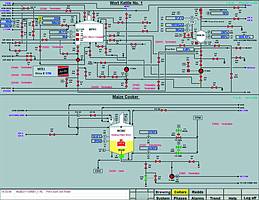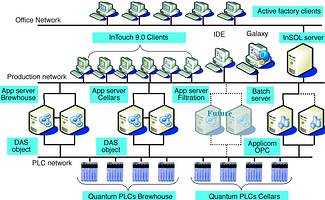
Reviewer details
Name: Stan Komar
Position/Designation: Software specialist
Company: SABMiller Prospecton
Telephone: 031 910 1294
E-mail: [email protected]
Reviewer details
Name: Pieter Venter
Position/Designation: Marketing and sales member
Company: Convenient Software Solutions (CSS)
Telephone: 031 903 5077
E-mail: [email protected]
Product details
Vendor: Futuristix
Product name and version: Archestra Version 2.1
Telephone: 011 723 9900
E-mail: [email protected]
URL: www.futuristix.co.za
General
Q: What industry (eg, mining, food and beverage, automotive etc) is the scada being applied in?
A: Food and beverage. The project has been implemented at SABMiller's Prospecton Brewery situated in KwaZulu-Natal. The project was given the name 'Project Lightyear' and included the replacement of the brew house scada system as well as the implementation of a new batch system. The project included all the brew house PLC software to be re-written.
Q: Describe the application briefly giving a description of any existing control systems, any previous scada system that was in place etc. If relevant, describe the switchover from the previous system.
A: The scada replaced was Monitrol, which was developed by Hilco Technology and installed more than 15 years ago. The system hardware was obsolete and no longer supported, and the application could not be installed on current server hardware, as this required a new version of UNIX on which Monitrol could not run.
Q: Who did the system integration?
A: The system integrator chosen to do the implementation was Convenient Software Solutions also known as CSS. They are KwaZulu-Natal based, servicing a variety of industry sectors. Their approach is to provide 'simple solutions for complex operations' thus reducing cost ownership for their customers by leaving them easy maintainable systems once the project is completed.
Q: Approximately how many man-hours did the integration take?
A: The complete integration took about one year from start to commissioning. Approximately 12 000 man-hours. The time allocated to the scada engineering is far less though as this total included the batch and PLC integration. Approximately 2100 hours were spent doing the scada integration.
Q: How is the after-sales support handled (eg, remote-dial-up, e-mail, Internet access etc)?
A: Currently CSS is still actively involved on the implementation of the next phases of the project as this is now rolled out to the fermentation cellars and shortly the filtration. Support is thus close at hand with the backing of Futuristix and Wonderware.
Q: What sort of licensing agreement is used on this particular system? Does one licence cover all modules, or can the user only buy those modules that he wishes to use?
A: The system licensing in short is as follows:
* Central to the system was the Application Object Server licence including device integration. This licence caters for the complete system (Galaxy) and is based on the total number of I/O.
* Several InTouch operator view stations were used using InTouch view licences with the required platform and bootstrap licences to access the Application Object Server.
* A tag Industrial SQL Server is used as the plant data historian and uses the required Active Factory licences for report generation and analysis of process variables.
System architecture
Q: How many tag points / I/O does the installation have? Analog? Digital? Maximum possible?
A:
* Analog - 110 000.
* Digital - 160 000.
* Maximum - in excess of 1 million.

Q: What operating system is the scada running on (eg Windows NT, Unix etc)?
* Application Object Server - Windows 2003 Server.
* View stations - Windows XP Professional.
Q: What impressed you most about the architecture? Open standards, wide range of drivers, the ability to upgrade, etc? Please elaborate.
A:
* The total flexibility and scalability of the system as you can start off small and later expand the licensing to include up to a million I/O tags across various application servers.
* Open standard using .net framework.
* Full redundancy as well as store and forward capability for the historian.
* Re-useable Objects and re-useable for the graphics.
Q: Is the system integrated onto an intranet or the Internet? If so, does the configuration allow simple remote monitoring, or is it configured to allow full remote control? If not, what level of intranet/Internet control does the scada allow for future use?
A:
* The system backbone is Ethernet TCP/IP from intranet to PLC level. The plant areas are divided by virtual LANs and the accessibility to the brewery intranet is via user profiles. Access to the Internet is via a central router, and it supports IP dialup for remote maintenance.
Q: What sort of redundancy is built into the system?
A: Dual Application Servers operating in parallel both accessing data from the PLC. Both these servers are constantly monitored and synchronised by a heartbeat. This did not require any additional licences and was simple to set up. Local data could be stored in event of network/InSQL unavailability thus no data loss. The data will automatically be logged into InSQL once the connection is re-sorted.
Graphics
Q: Describe the graphics development process - eg did you use standard library images, or did you have to draw images from scratch?
A: SAB Standards have been designed and are used throughout the applications. The use of Smart Symbols was introduced in InTouch 9.0, resulting in ease of updating the SAB standards. Re-useable graphics based on a single template and instances thereof were used in the application. Changes are propagated at template level to all instances when required. Smart Symbols have been applied to the ferment cellars phase of the project.

Q: How would you describe the library of graphic images?
A: The standard library within InTouch is very comprehensive and complete, and formed the basis of a lot of the standards that were developed.
Q: Did you use any 'special' images (eg, embedded video clips, photographs, 3D images etc)?
A: No.
Compatibility
Q: Did you run the scada in conjunction with any third-party application software? Describe.
A: Applicom OPC Server cards were used as the I/O servers.
Q: Does the scada allow for the user to create scripts to perform specific tasks? Describe any specific scripts that were written for this project.
A: Yes, addressing scripts were written to allow for auto PLC addressing. All the device popup information on the scada is populated by means of a single script associated to the device that the operator selected for display.
Management reporting
Q: Is a trending and historical data reporting system included? Please elaborate.
A: Both realtime and historical trending is available on each operator station. Other than some standard trends available, users/operators can configure their own in terms of what they want to trend on the screen. The historical trending and data is retrieved from the InSQL historian, which is part of the system.
Q: Is a management reporting system included in the package?
A: Active Factory was included in this project and is used to create user specific reports, by the people that require these reports from time to time. The reports can be done in Microsoft Word or Excel and incorporates both a static or dynamic web publishing capability through the use of the Active Factory Web.
Q: Is the system integrated into a manufacturing execution system?
A: Yes. A Batching engine has been implemented and the plant control is now recipe driven.
Q: Is the scada system integrated into a management reporting or control system (eg, SAP, Baan)?
A: No.
Q: Who integrated the scada into the MES and/or ERP?
A: The integration was completed by CSS.
Q: Describe the integration process.
A: The integration was based on the S88 batch implementation standards. All the control and unit module parameterisation is done via the scada
Q: Was any additional software development needed? Please elaborate.
A: No.
Conclusion
Q: What impressed you the most about the system?
A: Flexibility and scalability. The system can be as small as one tag and grow to a million tags, and it supports multiple application servers in one galaxy.
Structure to implement standards. The Archestra framework allowed for the modelling of the plant area to the S88 batch model standards.
Centralised development. Using only one galaxy environment it allowed for real ease of change propagation, and engineering efforts were re-used as standards were developed thus reducing total development time.
Archestra becomes the foundation for all your MES integration as it now supports production event objects which are plugged into the virtual plant model where recording of production data is required and offering full traceability of production including product, machinery and personnel.
Q: What was the predominant feature (or features) that made you decide to employ this scada, rather than another (ie ease of use, support from the vendor, upgrade path, redundancy features etc)?
A: Its flexibility and ease of maintenance.
The backup that we have received from Futuristix/Wonderware and CSS as the systems integrator.

© Technews Publishing (Pty) Ltd | All Rights Reserved